- Home
- Robert A. Heinlein
Off The Main Sequence
Off The Main Sequence Read online
Off the Main Sequence
The Other Science Fiction Stories of Robert A. Heinlein
Edited by Andrew Wheeler
Introduction by Greg Bear
Foreword by Michael Cassutt
Science Fiction Book Club
This is a work of fiction. All the characters and events portrayed in this novel are either products of the author’s imagination or are used fictitiously.
Stories Copyright (c) 2005 by The Robert A. and Virginia Heinlein Prize Trust
Successful Operation" (c) 1940 Robert A. Heinlein
'Let There Be Light’" (c)1939 Street & Smith Pubs., Inc. (c) 1950 Robert A. Heinlein
'—And He Built a Crooked House—’" (c) 1940by Street & Smith Pubs., Inc., (c) 1959 Robert A. Heinlein;
Beyond Doubt" (c) Robert A. Heinlein and Emma Wentz;
They" (c) 1941 Street & Smith Pubs., Inc. (c) 1959 Robert A. Heinlein;
Solution Unsatisfactory" (c) 1941 Street & Smith Pubs., Inc. (c) 1968 Robert A. Heinlein;
Universe" (c) 1941 Street & Smith Pubs., Inc. (c) 1951 Robert A. Heinlein;
Elsewhen" (c) 1941 Street & Smith Pubs., Inc. (c) 1953 Robert A. Heinlein;
Common Sense" (c) 1941 Street & Smith Pubs., Inc. (c) 1959 Robert A. Heinlein;
By His Bootstraps" (c) 1941 Street & Smith Pubs., Inc. (c) 1959 Robert A. Heinlein;
Lost Legacy" (c) 1941 Fictioneers,Inc. (c) 1953 Robert A. Heinlein. Copyright (c) renewed 1981 Robert A. Heinlein
'My Object All Sublime’" (c) 1942 Robert A. Heinlein;
Goldfish Bowl" (c) 1942 Street & Smith Pubs., Inc. (c) 1959 Robert A. Heinlein;
Pied Piper" (c) 1942 Robert A. Heinlein;
Free Men" (c) 1966 Robert A. Heinlein;
On the Slopes of Vesuvius" (c) 1980 Robert A. Heinlein;
Columbus Was a Dope" (c) 1947 Better Publications, Inc. (c) 1953 Robert A. Heinlein. (c) renewed 1981 Robert A. Heinlein;
Water Is for Washing" (c) 1947 Popular Publications, Inc. (c) 1959 Robert A. Heinlein;
Nothing Ever Happens on the Moon" (c) 1949 Boy Scouts of America. (c) 1976 Robert A. Heinlein;
Gulf" (c) 1949 (c) 1959 Robert A. Heinlein. (c) renewed 1981 Robert A. Heinlein;
Desination Moon" (c) 1950 Robert A. Heinlein;
The Year of the Jackpot" (c) 1952 Galaxy Publishing Corp. (c) 1959 Robert A. Heinlein;
Project Nightmare" (c) 1953 Ziff-Davis Publishing Co. (c) 1959 Robert A. Heinlein;
Sky Lift" (c) 1953 Greenleaf Publishing Co. (c) 1959 Robert A. Heinlein;
A Tenderfoot in Space" (c) 1958 Robert A. Heinlein;
—All You Zombies—" (c) 1959 Mercury Press, Inc. (c) 1959 Robert A. Heinlein
First SFBC Science Fiction Printing: October 2005
All rights reserved, including the right to reproduce this book or portions thereof in any form.
Published by arrangement with The Robert A. and Virginia Heinlein Prize Trust
c/o Spectrum Literary Agency
320 Central Park West, Suite 1D
New York, NY 10025
ISBN: 1-58288-184-7
Printed in the United States of America
Introduction
by Greg Bear
ReReading These Wonderful stories leaves me with the feeling that I have been present at the creation. There are so many ideas buried in here that may never have been thought of before — by human beings, at any rate. What a treat to have them all in one volume — and what a bargain, as well!
Here you will find “Universe" and “Common Sense", both published in 1941 — the first definitive stories about a generation starship, where entire cultures live and die on a massive craft cruising the unimaginable distances between the stars. (They were combined and published as the short novel Orphans in the Sky in 1963.) You’re about to meet the two-headed mutant Joe-Jim, smartest man on a very big ship, and his microcephalic and cannabalistic pal Bobo … both of whom prove, in their perverse and charming ways, that Heinlein was an equal opportunity kind of writer. (Note that Heinlein never actually shows Joe-Jim and Bobo snatching and eating babies.)
Here also is “They" (1941), in which solipsistic paranoia is fully justified — and “By His Bootstraps" (also 1941 — a banner year for Heinlein), which takes time travel pardoxes to a twisty new level — and “—All You Zombies —" (1959) which adds another turn of the screw that probably could not have been published in the period of “By His Bootstraps", And then there’s “—And He Built a Crooked House —" (1941), in which a 1940s black and white screwball comedy is combined with some Technicolor math and architecture to create the wackiest building ever conceived of — in California, which is saying a lot. (Imagine Cary Grant, Carole Lombard, and Cecil Kellaway in the starring roles …)
This volume perfectly complements an earlier omnibus of Robert Heinlein’s so-called Future History stories, which fit within a timeline. Heinlein was not the first to create a future history timeline — that credit probably goes to Neil R. Jones for his Professor Jameson series, for a multi-story sequence, or to H. G. Wells and Olaf Stapledon for single-volume works. But Heinlein was the first to spread the idea to a significant population of modern science fiction readers by actually printing his timeline in Astounding Science Fiction, and later in the collections “The Man Who Sold the Moon", (It’s also reprinted in the collections Revolt in 2100 and The Past Through Tomorrow.)
The Future History stories and novels are ground-breaking, to be sure, but the “Off the Main Sequence" tales in this collection are every bit as influential — and ore wide-ranging.
A few highlights:
“Solution Unsatisfactory" (1941) is Heinlein’s latter-day response to H. G. Wells’ “The World Set Free", Heinlein dispassionately tells of a future history of atomic poison and Cold War stalemate leading to a compulsory world state — which is no one’s desired solution. With chilling verisimilitude and political savvy, Heinlein lays out a precise view of the next twenty years of human history. Like Wells, Heinlein gets the spirit of the future right, if not the details. Anyone who lived through the Cold War and Mutual Assured Destruction will shiver with recognition.
“Gulf" (1949) is a novella of espionage, competing supermen, semantics, another Ultimate Weapon — and ultimate sacrifice. It’s a wild-ass tale bursting with didactic discussion and ideas, seemingly designed to fit right in with the then-current notion that science-fiction readers — were Slans, like A. E. van Vogt’s superhuman mutants. In fact “Gulf" reads like a tribute to A. E. van Vogt. Along with van Vogt, Heinlein was student of the then-in-vogue Alfred Korzybski, creator of General Semantics. (Look it up — naturally, there’s a great deal of material about Korzybski and his philosophy on the Web._ I also sense a touch of Hitchcock — a McGuffin and a conspiratorial ranch house straight out of Saboteur (1942) Heinlein pad a great deal of attention to contemporary films; his character’s speech patters, romantic relationships, and can-do attitude mirror those found in movies more closely even than most pulp stories, and that certainly contributed to his success and readability — but today, these patterns may seem dated. To appreciate “Gulf," origins, models, and Heinlein’s contemporary readership must be kept in mind.
Which leads to Heinlein’s actual film work …
“Destination Moon" (1950) is the story that resulted from Heinlein’s participation in the George Pal film of the same name, the most technically accurate science fiction film since Things to Come (1936), and until 2001: A Space Odyssey (1968). The movie’s ending is different, however — Heinlein allowed himself an ambiguous but probably apocalyptic conclusion. (There’s a concluding commemorative plaque here, as well as in “Gulf" …) George Pal, who firmly believed in relatively happy endings and box office r
eceipts, apparently thought this might be too strong for the audience of the day. Keep in mind, however, that a few years later, the movie version of James A. Michener’s The Bridges at Toko-Ri (1955) ends with the pilot’s death. Following the disillusionment of the Korean War, dark endings became a vogue, some much less heroic, Heinlein, as usual, was ahead of the curve.
It should be fairly chilling to read “The Year of the Jackpot" (1952), a brilliant, talky, and moving tale of statistics and final disaster. Chilling, because Heinlein mentions a Chief Justice Roberts, and in this year, 2005, we’re likely to have a Chief Justice by that name appointed to preside over the U.S. Supreme Court. Worth paying attention to in a number of Heinlein’s stories is the depth of his understanding of American culture and pop psychology — so much of what he describes in “Year of the Jackpot" could just as easily be transplanted into a story written today. In the context of grim statistical curves piling one upon another, the otherwise hokey romance and marriage — and bravery — of Potiphar Breen and Meade Barstow actually makes my eyes grow moist — and that shows how much Heinlein understood my psychology, as well.
Incidentally, Robert Heinlein has become a doyen to many modern conservatives, particularly Libertarians. “Year of the Jackpot" will provide both comfort and aggravation to rugged individualists. Heinlein was an equal opportunity charmer and puller of mustaches. You can never be certain what he will do or say next. To my mind, Heinlein’s three most controversial novels, Starship Troopers (1959) Stanger in a Strange Land (1961), and Farnham’s Freehold (1965) — are just such tweaks of the common American mustache. Heinlein loved to throw out philosophical tough steak — giving us all something substantial to chew on. Stuffed shirts on both sides of the political divide can spit gristle and huff and puff all they wish — that would delight Heinlein no end, I think.
Then there are the Lyle Monroe stories — puckish, a bit like L. Sprague de Camp, a bit like Thorne Smith, but with logical and science fictional touches that make them pure Heinlein. They remain a delight to read — trips back to a gentler sense of humor out of a deeply troubled but valiant and coping age.
Each of these stories has its own historical and science fictional delights. I’ve picked just a few .. and I’m sure you’ll have your favorites, and your own judgments — for that was what Robert Heinlein’s stories inspired: joy, reflection, sense of wonder, doubt, affection, anger, and controversy in equal measure.
And all very far away from anyone’s definition of main sequence.
Foreword
by Michael Cassutt
In the Spring of 1939, a disabled young former naval officer — recently an unsuccessful candidate for California State Assembly — sat down at his typewriter in a small house in the Hollywood Hills, and began to write a science fiction story. Four days later it was finished; he submitted it to Astounding Science Fiction, the best-paying magazine in the field, where editor John Campbell read it, and bought it.
The $70 payment (the equivalent of $1,500 in twenty-first-century dollars) not only improved the young politician’s bank balance, it gave him a career. Within two years Robert A. Heinlein would be considered the best, and most influential, science fiction writer in the world. Following a hiatus caused by World War II, he would expand his audience form the SF pulps to slick magazines like the Saturday Evening Post … to movies (George Pal’s Destination Moon) … television (Tom Corbett, Space Cadet) … young adult novels (the fantastically successful and influential Scribner juveniles) and controversial, even shocking adult works like Stranger in a Strange Land.
His stories not only entertained millions of readers around the world, they inspired a entire generation of engineers and rocket scientists, as wells as social experimenters on opposite ends of the political spectrum.
Robert Anson Heinlein was born July 7, 1907, in the small town of Butler, Missouri, the third child of a family that eventually numbered seven. His father, Rex, soon moved the family to Kansas City, where he became a clerk of various companies over the years.
Young Robert grew up in a city that was a growing commercial center — as the Rodgers and Hammerstein song later put it, “Everything’s up to date in Kansas City." To earn money, he sold magazines, was an office boy for Aetna Insurance, and had a paper route. (Two families on his route were those of actors William Powell and Jean Harlow.)
He was a bright youngster — learning to play chess when he was four. He grew interested in astronomy and mathematics, and became an omnivorous reader. Encountering Darwin’s Origin of the Species and the works of T. H. Huxley at the age of thirteen, he became a “free-thinker", privately rejecting his family’s Bible Belt fundamentalism.
He also discovered the adventure novels of Tom Swift and Frank Reade, as well as the speculations of Jules Verne and the write who would most shape his life and career, H. G. Wells. He enjoyed the fantasies of Rudyard Kipling, Jack London, Olaf Stapledon, and Edgar Rice Burroughs.
But it was the discovery of Hugo Gernsback’s Electrical Experimenter magazine at age sixteen that he became a fan of modern science fiction In his high school yearbook, a classmate would write that “he thinks in terms of the fifth dimension, never stopping at the fourth."
Heinlein’s family couldn’t afford to send the children to college. One older brother had enlisted in the Army during World War I. The next oldest, Rex, Jr., had earned an appointment to Annapolis.
Robert wanted an appointment, too, to either West Point or Annapolis (though he preferred the naval academy because of his interest in aviation and astronomy). Two successive appointments from the same family were out of the question. Robert found himself attending Kansas City Junior College for a year while continuing to solicit support for an appointment from Senator James A. Reed.
A member of the naval academy class of 1929, Robert prospered academically, ultimately graduating twentieth in a class of 243 — marked down for “offenses against military discipline," or he would have stood fifth. He was a member of the academy’s fending team, and was poised for service in naval aviation.
He entered the U.S. Navy at a time of great change — the service was in the middle of the painful process of evolving from a battleship-based fleet to one that integrated “aeroplanes."
Ensign Heinlein was assigned to the U.S.S. Lexington, the third carrier commissioned by the navy, serving under Captain Ernest J. King, later the Chief of Naval Operations in World War II. Here Heinlein was exposed to the latest developments in gunnery, communications, aircraft, and even deepsea diving. All of this experience would eventually shape his fiction.
Transferred to destroyer duty in 1932, Heinlein’s military career began to founder, weakened by seasickness, he was stricken with tuberculosis and in 1933 was hospitalized at a sanitarium in Monrovia, California. (His older brother, Rex, has suffered the same fate — indeed was hospitalized at the same sanitarium at the same time).
Heinlein’s T.B. was “arrested," but the recovery did not allow him to return to active duty. He was removed from active duty in August 1934 with the rank of lieutenant, junior grade, and given a small disability pension.
However, 1934 was the depth of the Depression. There were few jobs of any kind, certainly very few for young men with shaky health. Heinlein had a small pension; in 1932 he had married Leslyn MacDonald, an actress who later had a job in the music department at Columbia Pictures. He tried to sell real estate and to work in architecture. He also sat in on classes in physics and astronomy at UCLA. But because of his health, he was unable to find sustained employment, or to remain in school.
Always politically active and motivated — as were many young people in the 1930s — to encourage social change, Heinlein joined the End Poverty in California movement founded by activist writer Upton Sinclair.
Sinclair had run for governor of California in 1934, and had been defeated in a notoriously ruthless campaign. But his movement lived on, aligning itself with the mainstream Democratic Party.
Heinlein first did v
olunteer legwork for the movement, then joined the staff of its newspaper, ultimately becoming deputy publisher of EPIC News, with a circulation of two million. EPIC and its successors, Heinlein proudly reported, “recalled a mayor, kicked out a district attorney, replace the governor with one of our choice," all between 1934 and 1938.
There was one notable failure in the EPIC-Democrat movement — that of Heinlein’s political campaign. He ran for the 59th Assembly seat in the Hollywood Hills and Beverly Hills — his campaign contributors included the writer Dorothy Parker — against incumbent Charles Lyon, but was defeated in the August 1938 primary.
“There’s no prize for place or show in politics," Heinlein would write years later. But there is a price; he had taken out a mortgage of $1,000 on his house. In defeat … physically word down … with jobs hard to find … the mortgage a burden to a man supported only by a small naval disability pension … Heinlein turned to writing.
Although he would alter declare that he had suddenly been inspired to attempt a fiction-writing career by ill-health and indebtedness only in the spring of 1939, Heinlein had made attempts at fiction as early as 1930, composing a mainstream story set at the naval academy. In the fall of 1938 he wrote an entire novel titled For Us, the Living, which was submitted to and rejected by at least two major publishers. This utopian fantasy about a young naval aviator who is killed in a car crash, then resurrected in the future, espoused a then-shocking mixture of casual nudity, radical economic theories, and even simplified spelling.
Ideas aside, For Us, the Living was not a compelling story. Heinlein seems to have realized this, and put it aside.
Feeling that he had a better chance at making money with shorter lengths, in a few weeks in March and April 1939, he wrote two stories in this collection," 'My Object All Sublime’" and" 'Let There Be Light’," as well as “Lifeline."

 Job: A Comedy of Justice
Job: A Comedy of Justice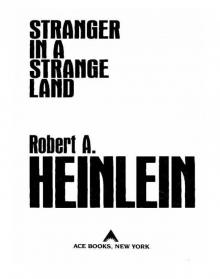 Stranger in a Strange Land
Stranger in a Strange Land The Worlds Of Robert A Heinlein
The Worlds Of Robert A Heinlein The Roads Must Roll
The Roads Must Roll Starship Troopers
Starship Troopers Farmer in the Sky
Farmer in the Sky The Past Through Tomorrow
The Past Through Tomorrow The Door Into Summer
The Door Into Summer All You Zombies
All You Zombies Friday
Friday Tomorrow, the Stars
Tomorrow, the Stars The Notebooks of Lazarus Long
The Notebooks of Lazarus Long The Moon Is a Harsh Mistress
The Moon Is a Harsh Mistress Beyond This Horizon
Beyond This Horizon Time Enough for Love
Time Enough for Love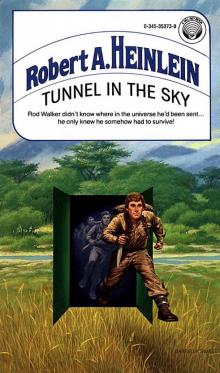 Tunnel in the Sky
Tunnel in the Sky Podkayne of Mars
Podkayne of Mars The Star Beast
The Star Beast The Cat Who Walks Through Walls
The Cat Who Walks Through Walls Grumbles From the Grave
Grumbles From the Grave Time for the Stars
Time for the Stars The Number of the Beast
The Number of the Beast The Unpleasant Profession of Jonathan Hoag
The Unpleasant Profession of Jonathan Hoag Sixth Column
Sixth Column To Sail Beyond the Sunset
To Sail Beyond the Sunset Revolt in 2100
Revolt in 2100 And He Built a Crooked House
And He Built a Crooked House The Pursuit of the Pankera: A Parallel Novel About Parallel Universes
The Pursuit of the Pankera: A Parallel Novel About Parallel Universes Expanded Universe
Expanded Universe Starman Jones
Starman Jones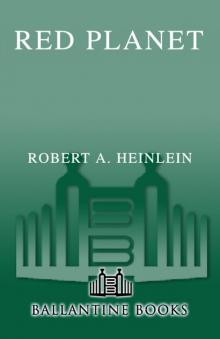 Red Planet
Red Planet Double Star
Double Star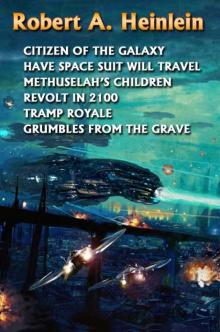 Citizen of the Galaxy
Citizen of the Galaxy Rocket Ship Galileo
Rocket Ship Galileo Glory Road
Glory Road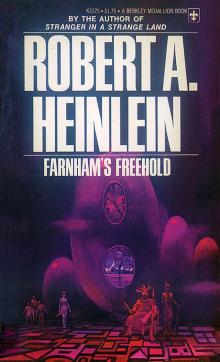 Farnham's Freehold
Farnham's Freehold Space Cadet
Space Cadet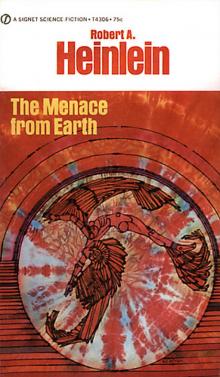 The Menace From Earth ssc
The Menace From Earth ssc Between Planets
Between Planets Methuselah's Children
Methuselah's Children Have Space Suit—Will Travel
Have Space Suit—Will Travel The Rolling Stones
The Rolling Stones Door Into Summer
Door Into Summer The Cat Who Walked Through Walls
The Cat Who Walked Through Walls Magic, Inc
Magic, Inc Off The Main Sequence
Off The Main Sequence Pied Piper
Pied Piper The Unpleasant Profession Of Jonathan Hoag And Other Stories
The Unpleasant Profession Of Jonathan Hoag And Other Stories Variable Star
Variable Star Waldo, and Magic, Inc
Waldo, and Magic, Inc Robert A. Heinlein: In Dialogue With His Century
Robert A. Heinlein: In Dialogue With His Century Waldo
Waldo Bulletin Board
Bulletin Board Job: A Comedy
Job: A Comedy Tramp Royale
Tramp Royale A Tenderfoot in Space
A Tenderfoot in Space For Us, the Living
For Us, the Living Destination Moon
Destination Moon Logic of Empire
Logic of Empire The Fantasies of Robert A. Heinlein
The Fantasies of Robert A. Heinlein The Menace From Earth
The Menace From Earth From the Notebooks Of Lazarus Long
From the Notebooks Of Lazarus Long Have Space Suit - Will Travel
Have Space Suit - Will Travel A Stranger in a Strange Land
A Stranger in a Strange Land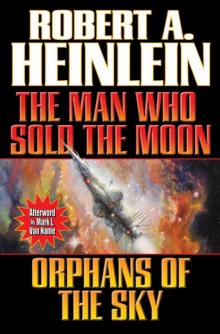 Man Who Sold the Moon / Orphans of the Sky
Man Who Sold the Moon / Orphans of the Sky